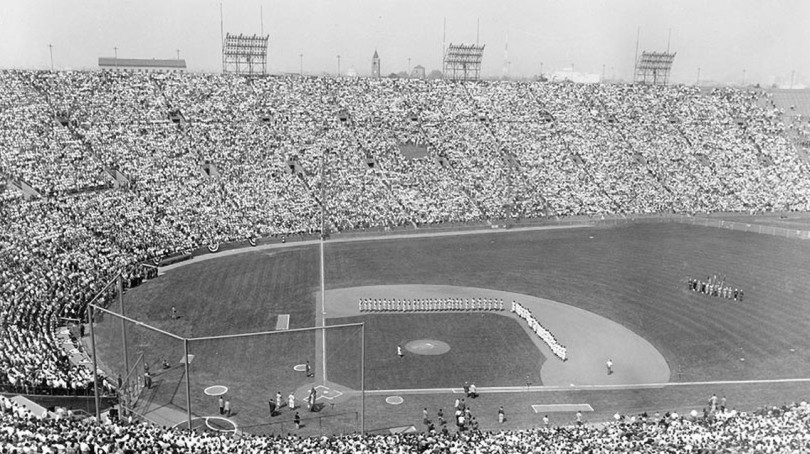
This general view shows the crowd of 78,682 at the Los Angeles Memorial Coliseum before gametime on opening day for the Los Angeles Dodgers on Friday, April 18, 1958. The Dodgers defeated the San Francisco Giants, 6-5.
AP Photo
Feature
History in the Making The First Major League Game in Los Angeles
By Brent Shyer
What a sense of elation Walter O’Malley must have been feeling as the Dodgers played their first game in Los Angeles on April 18, 1958. At least for the day, no clouds could rain on his parade. It was a perfect Southern California day; bright, sunny and clear with temperatures hovering around 70 degrees.
Having visited Los Angeles on only three occasions before making the momentous decision to go west with the Dodgers, O’Malley was not even sure where the ballclub would play months before Opening Day! Looking ahead a month and a half, a dark cloud hung over O’Malley, the Dodgers and the City of Los Angeles, as voters would be asked on June 3 to either accept a referendum known as “Proposition B” (affirming the approved contract between the Dodgers and the city) or reject it, which would send the team’s future into a tizzy.
Only after doors kept closing on him in Brooklyn in his decade-long challenge to replace aging Ebbets Field with its limited parking for 700 cars did O’Malley then look to broaden baseball’s borders. The footprint of the 16 major league teams extended no farther west than Kansas City in 1957. For several years, Los Angeles officials had tried to convince Major League Baseball that their city was ready to earn “big league” status and needed the popular Dodgers. Parallel to their friendly persuasion were the extended efforts of O’Malley to design, build, privately finance and maintain baseball’s first dome stadium at the intersection of Atlantic and Flatbush Avenues in Brooklyn. But, try as he might, O’Malley kept getting blocked in his request for assistance in assembling the needed land, which he would have purchased.
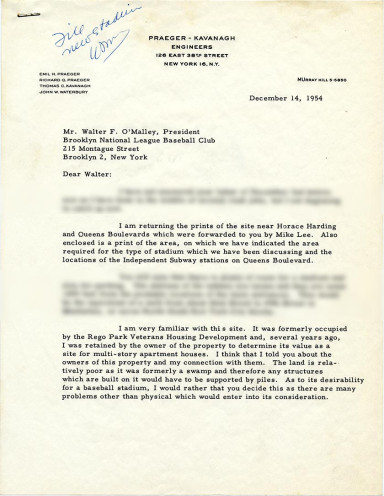
Letter from renowned engineer Capt. Emil Praeger to Walter O’Malley on December 14, 1954 regarding various concerns with land being considered as a site for a new ballpark for the Dodgers in Flushing Meadows, Queens.
The last straw seemed to come when powerful Robert Moses, Parks Commissioner for the City of New York, insisted on pointing O’Malley out of Brooklyn to Flushing Meadows, Queens to land that O’Malley and his highly-regarded engineer Capt. Emil Praeger had rejected years earlier because of its poor foundation. Letter from Capt. Emil Praeger to Walter O’Malley, December 14, 1954
The announcement that the Dodgers were drafting the Los Angeles territory on October 8, 1957, following the L.A. City Council’s approval of a contract with O’Malley and the Dodgers, set the wheels in motion for the significant westward expansion of major league baseball. While the Dodgers were heading to Los Angeles, the New York Giants had announced on August 19, 1957 that they were already moving to San Francisco for the 1958 season.
Horace Stoneham, owner of the Giants, had previously decided to relocate to Minneapolis. However, O’Malley suggested to Stoneham that he reconsider San Francisco. O’Malley even helped arrange a meeting at New York’s Hotel Lexington between San Francisco Mayor George Christopher and Stoneham to discuss possible terms of an agreement.
San Francisco voters had agreed to fund a municipal stadium, while Los Angeles voters turned down a proposition to subsidize a stadium in May 1955, long before the Dodgers considered Los Angeles. But, that was more than acceptable to O’Malley, who had made it clear that he desired to design, build, privately finance and maintain his dream baseball stadium. O’Malley saved the newspaper clipping of the decision of L.A. voters in his files.
O’Malley scrambled to make temporary arrangements for Dodger home games while Dodger Stadium was to be constructed. One possibility that O’Malley investigated late in 1957 was the famed Rose Bowl in Pasadena, but the exorbitant cost of converting the football field to a baseball diamond made it untenable. O’Malley had taken title to Wrigley Field, located at 42nd and Avalon in Los Angeles, on February 21, 1957 in an important exchange with Phil Wrigley, owner of the Chicago Cubs. Although it did give the Dodgers a place to play in a pinch, O’Malley still left his options open as the Los Angeles Memorial Coliseum was also on his list.
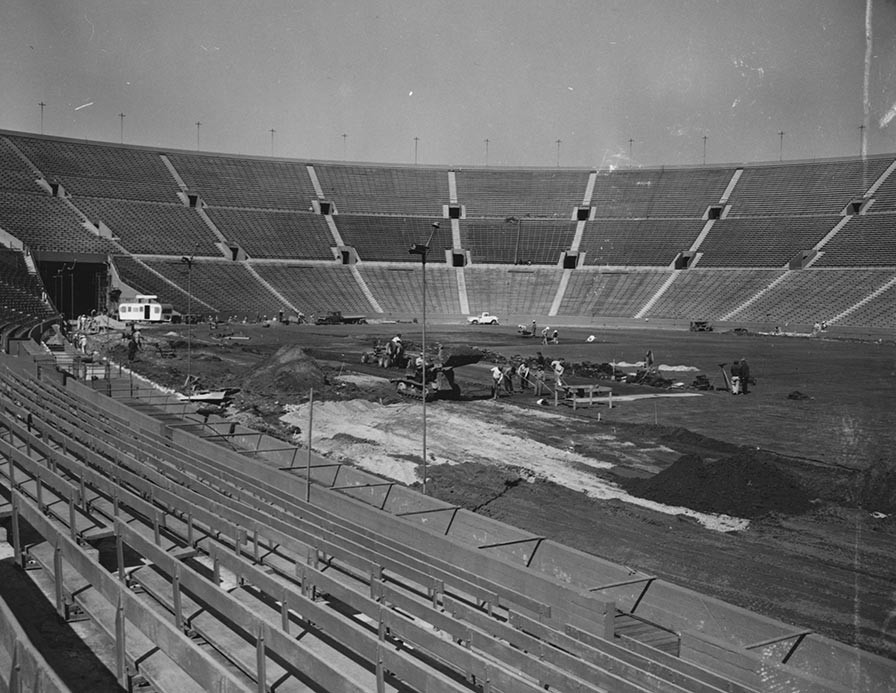
Construction has begun on a baseball diamond and field in the massive Los Angeles Memorial Coliseum in order to have a field ready for the Dodgers’ 1958 season.
Like the Rose Bowl, the historic 100,000-seat Coliseum was not designed for baseball. Football, track and field meets, the Olympic Games in 1932 and other significant events of local and national interest had been held at the Coliseum, but baseball was not among them. The Los Angeles Rams played there (since 1946), the UCLA Bruins and USC Trojans played home football games there and all those tenants, as well as other regularly held events, would have scheduling priority over the Dodgers. Regarding the prospects of the Dodgers playing in the Coliseum, O’Malley had written to Capt. Praeger on April 17, 1957 asking him to “Be good enough to have someone show how this could be laid out temporarily for a baseball field.”
The problem was that the Coliseum’s dimensions were not particularly compatible with baseball, as well as its east-west orientation. The Rose Bowl had a more favorable north-south orientation which helped with the setting sun. It was due to the stress and strain on O’Malley and his sleepless nights that he came up with his best concept for shoehorning a baseball field in the Coliseum’s existing frame. His proposed “3 a.m. Plan” before the Coliseum Commission in mid-January 1958 was to place a baseball diamond on the west end of the surface, necessitating the construction of a 42-foot high screen in left field due to the short distance of 251 feet to the fence.
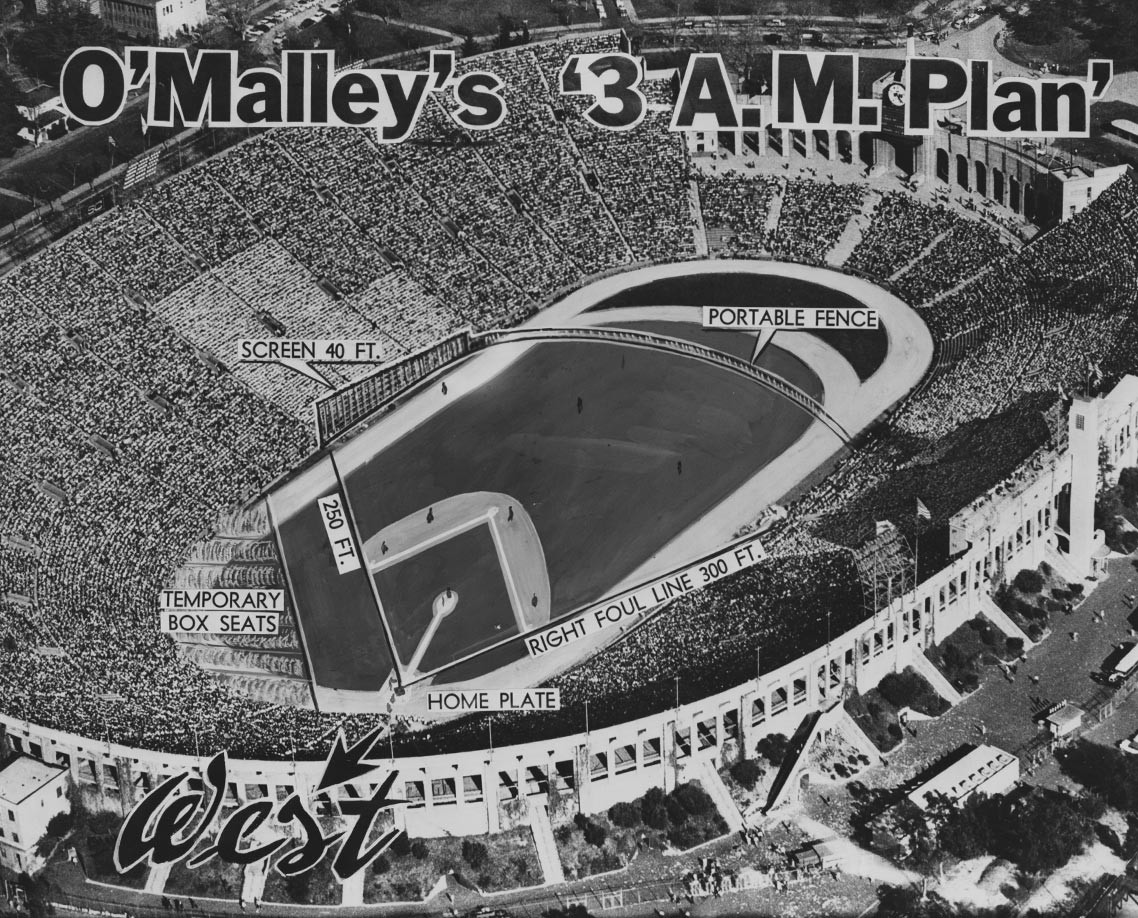
A newspaper article with photo discusses how Walter O’Malley devised a plan at 3 a.m. on how to place a major league baseball diamond within the Los Angeles Memorial Coliseum. The result was a short left field wall, 250 feet down the line, with a high 40-foot screen to run far into left center field to reduce short distance home runs. In addition, there are large power alleys to right center and right field. The concept was to get the approval from the National League to play baseball in the Coliseum, which the Dodgers did from 1958-1961, including a World Championship in 1959.
Certainly, by baseball standards this action would be unprecedented, but one that was deemed necessary in order to proceed with the use of the facility. Though O’Malley had no intent of making a mockery of the game or its dimensions, he reasoned that this makeshift solution at a temporary Dodger home field was acceptable. It would take a toll on the team, however, as left-handed pull hitter Duke Snider would not enjoy as much success at the Coliseum because of its cavernous right-center field dimensions. Dodger pitcher Ed Roebuck pretty well summed up the site: “It looks like Grand Canyon with seats.” Arthur Daley, The New York Times, April 18, 1958
When it was determined that the expense of converting the Rose Bowl was too pricey and the National League had also informed O’Malley that home games in Pasadena might leave the Los Angeles territory open to another team to relocate there, O’Malley dropped that idea. That left Dodger-owned Wrigley Field with its limited seating capacity (22,000) and parking (a problem similar to the one at Ebbets Field) and the Coliseum. In negotiations with the Coliseum Commission, O’Malley finally agreed on January 17, 1958 to pay $600,000 for a two-year lease as well as the nearly $300,000 needed to convert it to a baseball playing surface. The Coliseum Commission granted permission to O’Malley and the Dodgers with a unanimous 9-0 vote.
O’Malley rightly pointed out when some residents of Los Angeles opposed the Dodgers’ previously approved agreement with the City and forced the “Proposition B” referendum to let voters decide the Dodgers’ fate on June 3, 1958 that he was now bound to pay baseball’s highest rental at the Coliseum; owned and maintained Wrigley Field in L.A.; and was also paying maintenance expenses both at Ebbets Field in Brooklyn (where he had a three-year lease) and Roosevelt Stadium in Jersey City, New Jersey, where the Dodgers had played 15 “home” games in 1956 and 1957.
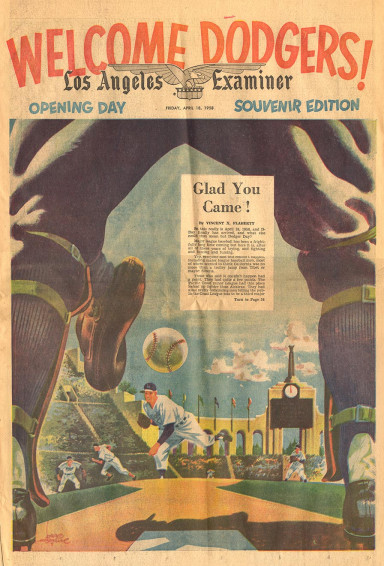
The Los Angeles Examiner publishes a special color souvenir edition for the Dodgers’ first game in Los Angeles. The artwork depicts the home plate umpire’s view of the revamped Los Angeles Memorial Coliseum and the headline “Glad You Came!”
Several key Dodgers, including catcher Roy Campanella, shortstop Pee Wee Reese, center fielder Duke Snider, first baseman Gil Hodges and Manager Walter Alston were asked by O’Malley to assist the team’s community relations and ticket sales during that first winter in Los Angeles. With 30,000 season tickets sold by the end of 1957, Los Angeles was abuzz about the impending arrival of the Dodgers, who had paid $450,000 in territorial rights to the Pacific Coast League for the market. Major League Baseball was about to make its West Coast debut just three months after O’Malley had decided on where the Dodgers would play.
“I played the last game in Brooklyn and anticipated going to L.A. – I had been to L.A.,” said three-time National League MVP Campanella. “I went out to see the Coliseum and the short left field fence. It made me feel good, but I never got to play there. Before my (auto) accident (on January 28, 1958), Mr. O’Malley had the skipper Walter Alston, Pee Wee Reese, Duke, Vin Scully, myself and I think Gil Hodges in L.A. We were like in community relations, selling tickets. For two weeks we would be in L.A. and half of us would go back home to New York, or wherever we lived, and vice versa. But, we sold tickets after the season of ’57 in Brooklyn, we sold tickets in L.A. We had quite a schedule.”
A tragedy shocked the baseball world when Campanella was paralyzed from the neck down in his well-documented single-car automobile accident. O’Malley immediately went to visit Campanella in the hospital and made arrangements for his long-term well-being.
The first games of the inaugural season on the West Coast would be played in Seals Stadium in San Francisco – the Giants’ temporary home (1958-59) until Candlestick Park would be built by the city and its taxpayers. In that series, the Dodgers dropped two of the first three games before returning home on Thursday evening April 17 to attend a Baseball Writers Association of America, Los Angeles chapter banquet at the swanky Biltmore Bowl in downtown Los Angeles.
O’Malley and the Dodgers received plaudits from 1,200 enthusiastic fans welcoming the Dodgers, despite that afternoon’s 7-4 loss to the Giants. Art Linkletter served as master of ceremonies, while Dinah Shore and Bob Hope provided entertainment. Speakers included Commissioner of Baseball Ford C. Frick and National League President Warren C. Giles, who delivered welcome messages. O’Malley told the crowd, “It’s been a fascinating honeymoon here. Tomorrow, we hold open house in the Coliseum and on June 3 (the date the public votes on Proposition B, to ratify or reject the city’s approved contract with the Dodgers) we hope to make it all legal.” TV personality Linkletter said, “I understand Walter O’Malley is building an ulcer-shaped swimming pool here,” referring to the looming “Proposition B” referendum. Giles said, “O’Malley’s move was a bold one but it was more than that. It’s a solid expression of faith in the people of Los Angeles. We have faith in you folks and I hope you have faith in us.”
Frick told attendees at the banquet, “Being a New Yorker, I have mixed emotions. The Dodgers and Giants coming West is New York’s loss and your gain. We regret that loss. Yet I must confess, this is the greatest move baseball has ever made.” Rube Samuelson, “Rube-Barbs”, April 19, 1958
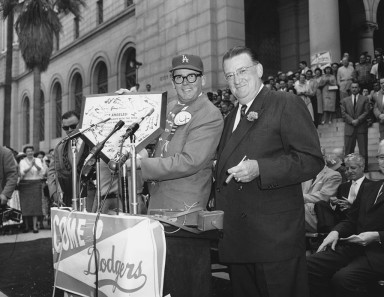
Ceremonies were held on the steps of Los Angeles City Hall prior to the Dodgers’ first home game in Los Angeles on April 18, 1958. Dodger President Walter O’Malley (right) presented Los Angeles Mayor Norris Poulson home plate signed by the Dodgers from Ebbets Field in Brooklyn as they begin their initial season in Los Angeles.
AP Photo
The next morning, Friday, April 18, Dodger players and executives assembled in downtown Los Angeles for a 10:30 celebration on the Spring Street steps of City Hall and a huge welcoming parade through the city. Thousands of adoring fans lined the sidewalks and spilled onto the city streets to wish the Dodgers well in their new hometown and in their first home game at the Coliseum. The Dodger players greeted the throng in their thongs, as they wore white rubber shower sandals, and loaded two by two in awaiting convertibles. From downtown, the 22-car Dodger motorcade headed south and west a few miles to the Coliseum for the afternoon game with the San Francisco Giants. The parade route was dotted by “Welcome Dodger” banners and even colorful horse-riding James “Foghorn” Murphy was on the streets with a megaphone shouting “Play ball!” Art Ryon, Los Angeles Times, April 19, 1958
At the Coliseum, the festivities were also of a celebratory nature as the pregame ceremonies included Los Angeles Mayor Norris Poulson throwing the first pitch to batter San Francisco Mayor Christopher, who was “booed good-naturedly,” at home plate. Doug Mauldin, Pasadena Star-News, April 19, 1958 Poulson had proclaimed “Welcome Dodger Week” beginning April 13. Comedian Joe E. Brown was selected to serve as emcee of the ceremonies, which included introductions of Commissioner Frick and National League President Giles.
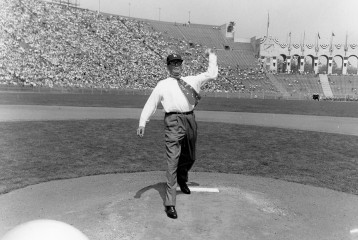
Los Angeles Mayor Norris Poulson, an influential civic leader in bringing the Dodgers west, is shown throwing the ceremonial first pitch on the mound of the Los Angeles Memorial Coliseum on April 18, 1958. Poulson is wearing a baseball tie that reads, “Los Angeles Dodgers.”
Courtesy of University of Southern California, on behalf of the USC Specialized Libraries and Archival Collections
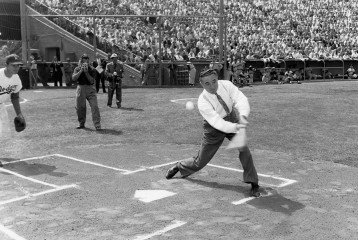
George Christopher, Mayor of San Francisco, takes a swing at a ceremonial first pitch at Opening Day in Los Angeles. Photo taken April 18, 1958.
Courtesy of University of Southern California, on behalf of the USC Specialized Libraries and Archival Collections
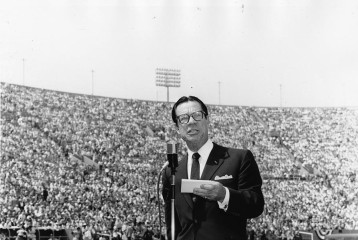
Comedian and first game in Los Angeles emcee Joe E. Brown speaks during ceremonies at the Los Angeles Memorial Coliseum on April 18, 1958.
Courtesy of University of Southern California, on behalf of the USC Specialized Libraries and Archival Collections
The Governor of California Goodwin Knight and Attorney General Pat Brown were also in attendance. Kenneth Hahn, the Los Angeles County Supervisor who was actively involved in helping to bring the Dodgers to L.A., was there. Mayors of all Los Angeles County communities and civic officials were invited guests of the Dodgers in a special “coaches” box section. Mrs. John McGraw, widow of legendary Giants Manager John McGraw was in attendance, as was Hall of Fame outfielder “Wahoo Sam” Crawford. Even songwriter Jack Norworth, who wrote the famous lyrics to “Take Me Out to the Ball Game” 50 years earlier in 1908, was a guest of the Dodgers.
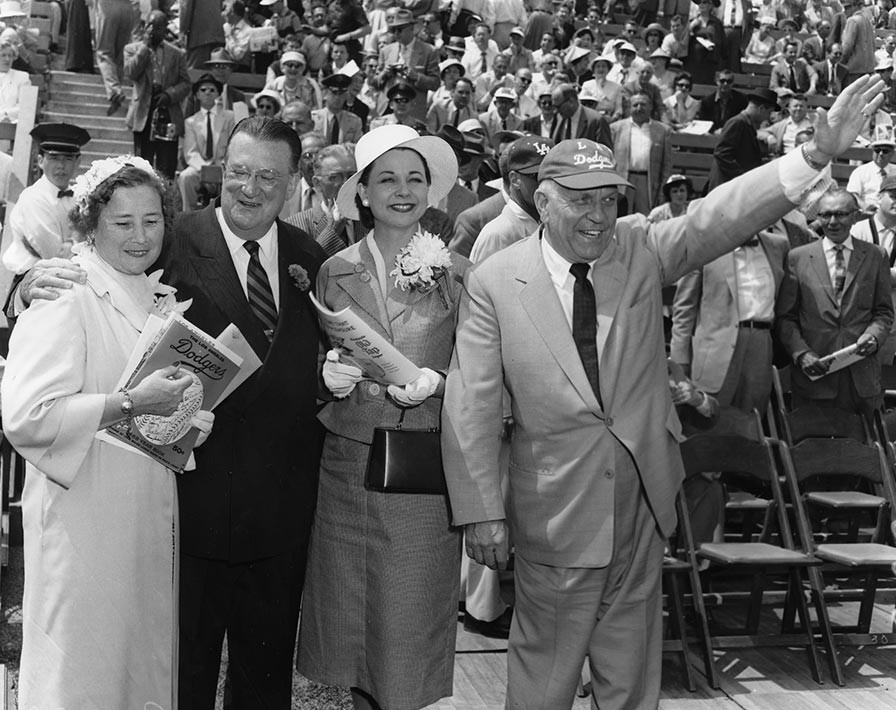
Prior to the very first Dodger home game to be played at the Los Angeles Memorial Coliseum on April 18, 1958, Kay and Walter O’Malley (left) greet Mrs. Virginia Knight and her husband California Governor Goodwin Knight. Governor Knight was in office from 1953-1959 and had two Major League Baseball teams in California.
Courtesy of University of Southern California, on behalf of the USC Specialized Libraries and Archival Collections
Twenty-seven year old Los Angeles City Councilwoman Rosalind Wyman sat proudly with her husband Gene next to O’Malley and his wife Kay in special chairs situated on the playing field level. A devout baseball fan, Wyman’s unwavering courage, leadership and strength encouraged the Dodgers for three years to come to Los Angeles – even when it seemed only a remote possibility – and fulfill the city’s major league dreams. Against her doctor’s wishes, Wyman was there 13 days after giving birth to her first child (daughter Betty). O’Malley wore a “Dodger blue” flower in his lapel, while First Lady Kay and their daughter Terry were attired in all blue. Dodger part-owner Dearie McKeever Mulvey and her husband James (President of Samuel Goldwyn Productions) also sat in that area.
United States Vice President Richard M. Nixon sent a telegram to the “Welcome Dodgers” Committee which read: “I deeply regret that preparations for my extensive South American visit will make it impossible for me to be with you when the Dodgers begin their first historic season in Los Angeles. I am sure that Los Angeles will make this a most memorable and colorful event and that it will support the Dodgers with all the enthusiasm so characteristic of the city. Best wishes for a successful opener and a highly productive season.”
The curious Hollywood celebrities were out in force to support the Dodgers. Actress Zsa Zsa Gabor was even asked to write a column for United Press about the arrival of the Dodgers, stating, “I am delighted about major league baseball coming to Los Angeles – with all those men and that enormous diamond, what woman wouldn’t be?” UP, April 19, 1958
It was hard to say which was more impressive, the Dodger lineup or the lineup of Hollywood stars gracing the stands. The Dodger starters were Jim Gilliam, LF, Pee Wee Reese, SS, Duke Snider, CF, Carl Furillo, RF, Gil Hodges, 1B, Charlie Neal, 2B, Dick Gray, 3B, John Roseboro, C and Carl Erskine, P. Celebrities Jimmy Stewart, Danny Kaye, Edward G. Robinson, Billy Wilder, Bing Crosby, Lana Turner, Ray Bolger, Jeff Chandler, Gregory Peck, Alfred Hitchcock, Lauren Bacall, Chuck Connors, Burt Lancaster, Jack Lemmon, Nat King Cole, Danny Thomas, Dinah Shore, Buddy Rogers, Ralph Edwards, Tennessee Ernie Ford, Groucho Marx, Gene Autry, producer Mervyn Leroy and “Toastmaster General” George Jessel were all socializing amongst the other paying customers for Opening Day. Dodger ticket prices established by O’Malley: 75 cents for a children’s ticket and box seats ranging from $1.50 to a maximum of $3.50. Those family-friendly ticket prices would remain unchanged by O’Malley for 18 years.
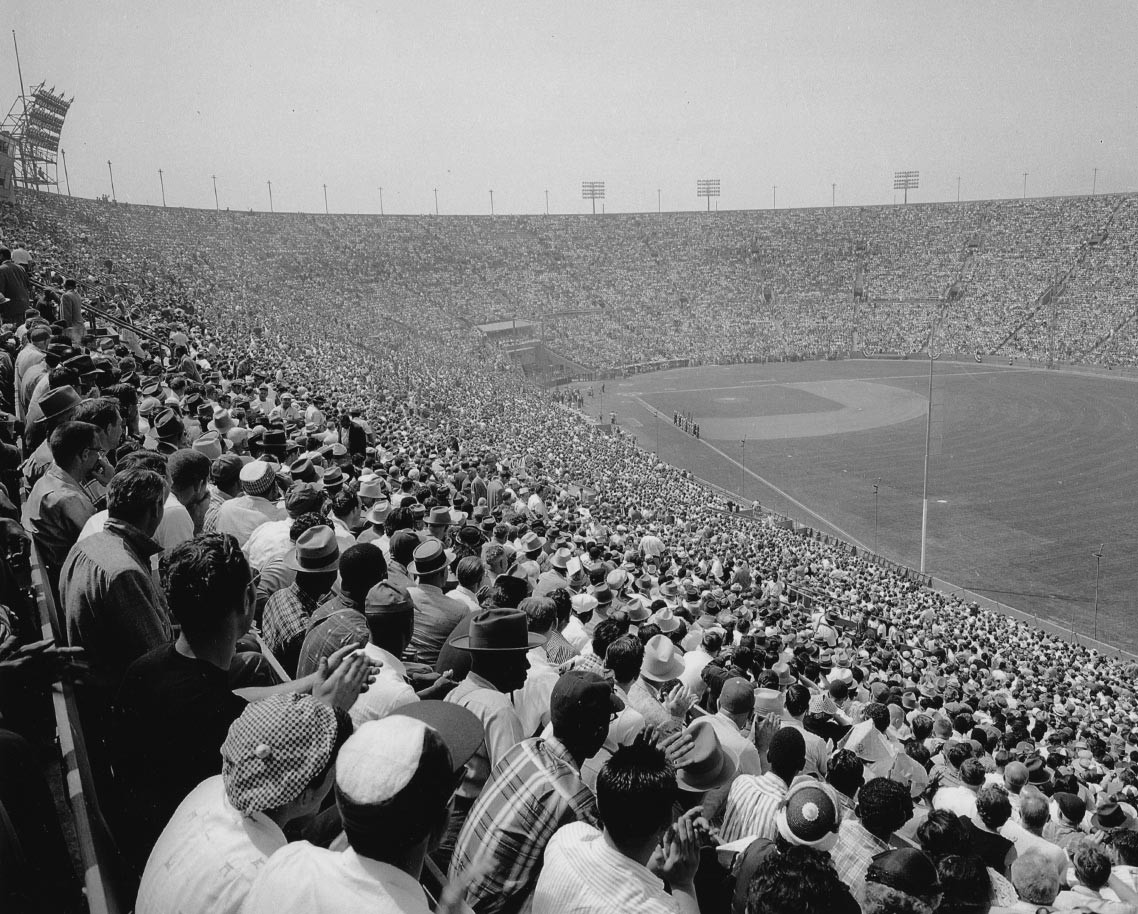
On Opening Day, April 18, 1958, the Dodgers hosted the San Francisco Giants to an Opening Day crowd of 78,672, still a major league attendance record for an Opening Day.
Los Angeles Times Collection, UCLA Library Special Collections
An enormous crowd of 78,672 began filing into the Coliseum at 10 a.m. to watch the first major league game in Los Angeles, as anticipation began to build for the scheduled 1:45 p.m. start. Erskine had been selected by Dodger Manager Alston to start on the mound that day, mainly because he was an experienced pitcher who had been in big games before, including pitching in five World Series. “My choice was a guy named Mr. Erskine,” said Alston. “He had pitched well in the past and had a good spring. He had an outstanding curve and probably one of the best changes I’ve ever seen and was a little sneaky fast, so he was my choice.”
But even Erskine, who wanted to do so well and make an early impression to an entire city, was feeling the pregame butterflies. The only person he knew outside of his teammates was a church friend from his hometown of Anderson, Indiana who had relocated to Los Angeles. Erskine found his friend’s name in the phone book and invited him to attend the game and lend support.
The thought of performing in front of the gigantic crowd – which shattered four attendance records: largest regular season (surpassed 78,382 for Chicago White Sox at Cleveland game on August 20, 1948); largest Opening Day (bested the 74,200 for Boston Red Sox at New York Yankees, April 18, 1923); largest Opening Day in Dodger history (previously 34,530 for Giants at Dodgers in Brooklyn’s Ebbets Field); and largest in National League history (beating 60,747 for Dodgers at Giants doubleheader at New York’s Polo Grounds on May 31, 1937) – was daunting.
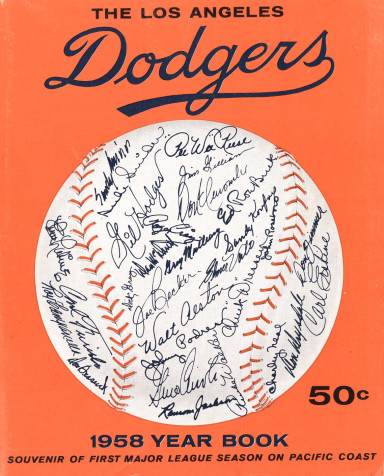
The inaugural Los Angeles Dodgers Yearbook cover of 1958 depicts the facsimile autographs of the players and Manager Walter Alston.
Next, Alston added a little fuel to the fire by informing 32-year-old Erskine that he wanted him to throw a strike to Giants rookie infielder Jim Davenport, who was sizzling at the plate collecting four straight hits the day before in San Francisco, and then throw a brush back pitch. As uncharacteristic as this was for Alston to demand, Erskine understood that it was intended to send a message to the Giants and Davenport and he would follow the boss’s order. Giants Manager Bill Rigney, who already suffered from an upset stomach, remained in an Oakland hospital and was unable to man the controls, giving way to Coach Herman Franks.
“I was toward the end of my career by the time we moved to Los Angeles,” said Erskine. “I was very honored that Walt selected me to pitch the opener there. I’ll be honest with you, I was nervous. That was a big crowd, it was a football stadium. It was a whole new group of people. It was sort of like proving yourself over again. I was pretty keyed up that day and playing the Giants to boot. Walt talked to me before the game. He said, ‘I want you to get ahead of (Jim) Davenport,’ who was red hot up in San Francisco in the first couple of games. He said, ‘Get ahead of him and then I want you to (brush him back). I know you don’t like to do that, but I’m going to order you to do it.’ So, I did. I was a little nervous all night, the night before. I wanted to be sure I threw a strike.”
Everything about the Coliseum as compared to Ebbets Field was so different. Certainly, the first of these was the short left field distance (251 feet) with a 42-foot high screen to cut down on “gimme” home runs. But, it was an enticing distance even for left-handed batters who tried to loop the ball over the fence or hit the screen on the fly. The long distance of 440-feet to right-center field made it a morgue for batters who went that way. Also, fielders had to adjust to the largely white-shirted crowd in the Coliseum and try to find the ball amongst the nearly 80 rows of customers. “There is no other ballpark in the league like it now,” said Dodger team captain Reese. AP, April 19, 1958 Another phenomenon was about to take place – the popularity of the game on radio, not just at home, driving, or at the office, but right in the stands themselves.
Vin Scully, 30, and partner Jerry Doggett, 41, who were asked by O’Malley to come west with the Dodgers after the 1957 season, broadcast the extensive home Opening Day pregame ceremonies and the game on KMPC Radio and, right from the start, transistor radios became a must-bring to the vast Coliseum.
The ever-popular Scully was starting his ninth season with the Dodgers, while Doggett was in his third, after spending time impressing fans and advertising executives announcing in the Texas League. But, O’Malley also wanted to make sure that the burgeoning Hispanic population in Southern California could hear Dodger games, so he worked out an agreement with KWKW Radio to put home games in Spanish-language on the air in 1958 with the talented crew of Rene Cardenas, Miguel Alonzo and Milt Nava at the microphones. “I was there broadcasting live, hanging from the tunnel. All the radio booths were hanging from the tunnel in the Coliseum,” recalls Cardenas. “It was fantastic! The crowd was the greatest that I had seen and the Dodgers had seen in my lifetime.” O’Malley’s forward thinking was a continuation of selected home games in Spanish-language since 1954 in Brooklyn on New York’s WHOM Radio with unparalleled Buck Canel broadcasting.
When Quito, Ecuador native Jaime Jarrin joined the Dodger Spanish-language radio broadcasts in 1959 replacing Nava, baseball’s popularity would continue to cultivate in a substantial market. The first game would not be televised in Los Angeles. O’Malley had announced that there would be no home games on television in 1958. As to road games, it was resolved on April 27 that all games against the rival Giants would be on KTTV Channel 11 beginning May 9. More than 150 newspapers sent writers to cover the Dodger home opener at the Coliseum, 50 more than were in San Francisco. Hank Hollingworth, “Sports Merry-Go-Round”, Press-Telegram, April 19, 1958
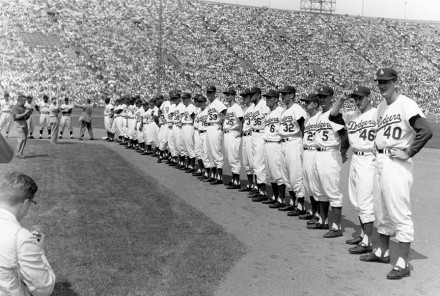
Los Angeles Dodgers and San Francisco Giants take their positions for pregame introductions for the opening game in Los Angeles on April 18, 1958 at the Los Angeles Memorial Coliseum.
Courtesy of University of Southern California, on behalf of the USC Specialized Libraries and Archival Collections
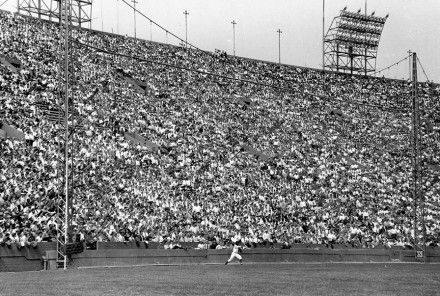
Popular Dodger Jim Gilliam patrols left field for the Dodgers in the first game at the Los Angeles Memorial Coliseum on April 18, 1958. Gilliam’s uniform No. 19 was retired on October 10, 1978.
In an effort to move the players closer to the majority of the fans in the Coliseum, the Giants and the Dodgers were introduced and lined up on the infield between first and second base (Dodgers) and between second and third base (Giants), rather than on the traditional foul lines running from home to first and home to third. Johnny Boudreau’s band accompanied a choral group led by coordinator J. Arthur Lewis from the L.A. Bureau of Music which sang the national anthem, as the enormous crowd also joined in. The loudest ovation of the day came when it was announced that while Dodger catcher Campanella was recuperating in a New York hospital, the sad result of his automobile accident, he was being represented on the diamond by Toluca Lake Grammar School student “Scoop” Remenih, who won a KMPC Radio contest to claim the honor. The proud 11-year-old wore a Dodger uniform adorned with Campy’s number 39.
Manager Alston said of Campanella, “Roy Campanella would have been the guy who could have really taken advantage of the left field wall (in the Coliseum). He was a pull hitter and he hit a lot of long balls to left field and he would have been the guy that the park really fit. I began to wonder whether that wall would be a hindrance or a help to us. That right field was a country mile.”
Snider said because of the morning parade, neither the Dodgers nor the Giants took batting practice before the game and entered the strange surroundings of the oval-shaped Coliseum with trepidation. “Having grown up in Compton, I attended a lot of football games there, including UCLA, USC and even the Rams (starting in 1946). I was in awe.”
After a whirlwind of a night and day, finally, it was time for the Los Angeles chapter of the Dodgers to play ball at home.
Right-hander Erskine said that he was so focused on getting his strike to leadoff hitter Davenport that he could worry about little else. He released a fastball, the first pitch thrown in Los Angeles, for a strike! The next pitch was the brush back one ordered by Alston to the hot-hitting Davenport. It was right at the bill of Jim’s cap and pushed him off the plate. But, like every good hitter, Davenport got right back in the box and lined the next pitch off the center field fence for a long single, the first hit in Coliseum and L.A. major league history. Neither team scored in the first two innings, as the Giants ran themselves out of the first inning Keystone Kops’ style on an infield-fly rule popup. As Erskine lost the pop fly in the bright sun, two Giants wound up at second base and the Dodgers got a gift double play.
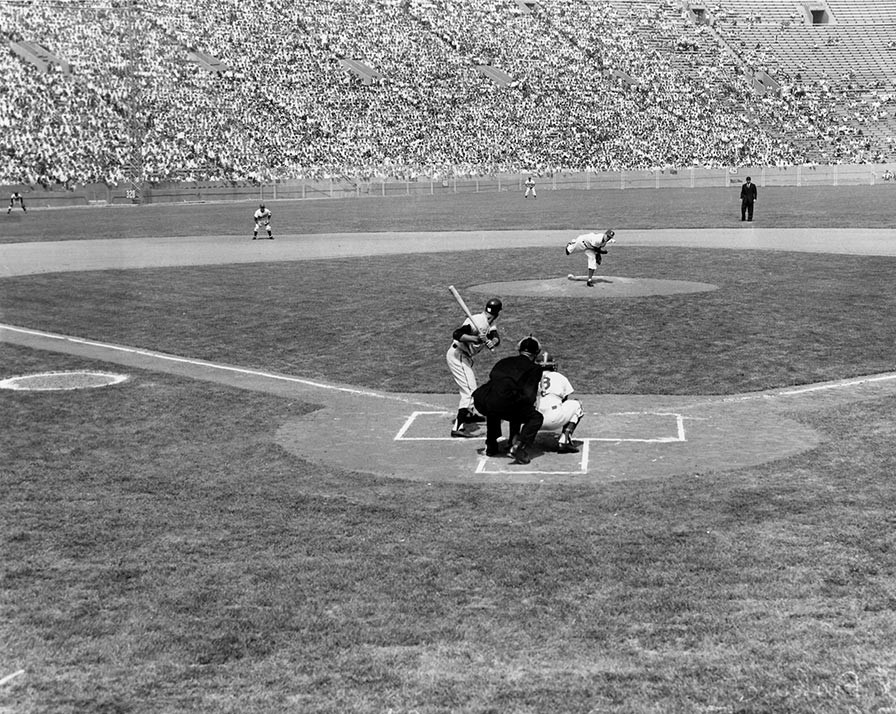
The first pitch of Major League Baseball in Los Angeles is thrown by right-hander Carl Erskine to Giant third baseman Jimmy Davenport on April 18, 1958 at the Los Angeles Memorial Coliseum.
Courtesy of University of Southern California, on behalf of the USC Specialized Libraries and Archival Collections
The Giants pushed across a run in the third inning as a sizzling Davenport collected his sixth consecutive hit, a single, off Erskine on a ball hit 30 feet up the left field screen. He advanced to third on Willie Kirkland’s double down the left field line. After Willie Mays was intentionally walked, Erskine walked Daryl Spencer to force in the run. But, the Dodgers came right back to score runs in the last of that inning to go ahead, 2-1. Gilliam walked off pitcher Al Worthington and moved to second on a ground out by Reese. Snider singled to center at Mays’ shoe tops, scoring Gilliam and advanced to second as the ball got past Mays. Neal singled to center and Snider scored sliding into home beating Mays’ throw to the plate.
The Dodger lead was short-lived as Hank Sauer hit Erskine’s 0-2 pitch for a home run, the first major league shot in Coliseum history, in the top of the fourth inning. The ball did not clear the 42-foot left field screen, instead going just beyond the end of it some 340 feet to left center. With the game tied 2-2, the Dodgers scored three runs in the fifth inning off Worthington to surge ahead 5-2. With one out, Neal walked and advanced to second on Gray’s base hit to left. Cimoli singled to right field with Neal scoring and when the ball kicked off Giants’ rookie catcher Bob Schmidt’s glove, Gray scored, as well, with Cimoli going to second. The huge crowd was electrified at that moment and roared its collective approval. Mike McCormick replaced Worthington and got pinch-hitter Randy Jackson to hit a comebacker with Jackson thrown out at first and Cimoli reaching third. Then, McCormick unleashed a wild pitch to score Cimoli with the fifth Dodger run.
But, the Giants would not go away quietly off Erskine, who surrendered a two-out triple to deep center field by Schmidt in the sixth inning and a wild pitch to make it 5-3 Dodgers. In the seventh inning, the Dodgers scored again on a 345-foot home run by Gray off Johnny Antonelli. The Giants clawed back to score a run in the eighth inning on Sauer’s second home run of the game, this time a bomb clearing the high left field screen. Interestingly, slugger Sauer was a resident of Inglewood, California located just a few miles from the Coliseum.
Erskine headed to the mound to try to complete the game in the ninth inning, leading 6-4. But, Davenport launched a ball that hit a stanchion high up above the 42-foot restraining bar on the left field screen and it caromed back onto the field, which was in play according to ground rules. Davenport wound up with a double instead of a home run. Ace reliever Clem Labine was brought in to replace Erskine, who had thrown 129 pitches. Kirkland belted a 430-foot triple to deep center off Labine, but on his way to home plate from second, Davenport missed touching third base. Instead of making the score Dodgers 6-5, it was still 6-4 after the appeal play was upheld.
“My feet got tangled, causing me to get off stride,” explained Davenport after the game. “I knew I missed the bag and started back. But there was Willie Kirkland coming in, so there was nothing to do but go ahead and hope nobody noticed it.” Los Angeles Times, April 19, 1958
Mays contributed an infield single which scored Kirkland to make it 6-5 and Mays advanced to second on Reese’s throwing error. But, when Spencer flied to Cimoli and Orlando Cepeda fouled out to catcher Joe Pignatano, the Giants stranded Mays at second, and the Dodgers won the hard-fought, three hour and six-minute game, 6-5. One account about the exciting contest noted, “Few fans left before the final out.” Doug Mauldin, Pasadena Star-News, April 19, 1958
For veteran Erskine, he had given up 10 hits and four runs while striking out seven and walking four. He picked up the victory to go 1-0 and earn the first victory in Los Angeles. “I do know I threw more curves today than I’ve ever thrown before,” said Erskine after the game explaining his stuff. “But you can’t throw fastballs all day with that inviting screen. I’m very happy about the win. I know Mr. O’Malley was anxious for us to win this first one at home. That big crowd was a thrill, all right. While I was warming up I couldn’t help but feel it was like the atmosphere at a World Series.” Charlie Park, Mirror News, April 19, 1958
Third baseman Gray, who homered in Seals Stadium and the Coliseum, noted: “I really tagged that one today. But, I was more proud of the fact that I caught that boy Davenport missing third base. I always watch the runners when they pass third base to see if they touch the bag. Catch some now and then, too. I was only hoping the ump saw him miss the bag, too. If he hadn’t caught the play, he’d sure had an argument from me, I tell you.” Longtime Dodger team captain Reese added that the Dodgers could not be called “daffy” any more. “Not after a Giant boots away a game by missing third,” he said smirking. Hank Hollingworth, Press-Telegram, April 19, 1958
Come to think of it, O’Malley also must have left the Coliseum with a smile on his face.
| Team | 1 | 2 | 3 | 4 | 5 | 6 | 7 | 8 | 9 | R runs | H hits | E errors |
|---|---|---|---|---|---|---|---|---|---|---|---|---|
| Giants | 0 | 0 | 1 | 1 | 0 | 1 | 0 | 1 | 1 | 5 | 12 | 2 |
| Dodgers | 0 | 0 | 2 | 0 | 3 | 0 | 1 | 0 | X | 6 | 8 | 2 |
(Scroll to the right if full line score isn’t visible.)
Giants
5
2-2
Lost 1
3rd, 1½ GB
Dodgers
6
2-2
Won 1
3rd, 1½ GB
BATTING
San Francisco Giants | AB | R | H | RBI | BB | SO |
|---|---|---|---|---|---|---|
J Davenport 3B | 5 | 1 | 3 | 0 | 0 | 0 |
W Kirkland RF | 5 | 1 | 3 | 0 | 0 | 0 |
W Mays CF | 4 | 0 | 2 | 0 | 1 | 0 |
D Spencer SS-2B | 4 | 0 | 0 | 1 | 1 | 0 |
O Cepeda 1B | 5 | 0 | 0 | 0 | 0 | 2 |
H Sauer LF | 4 | 2 | 2 | 2 | 0 | 2 |
B Schmidt C | 3 | 1 | 2 | 0 | 1 | 0 |
D O'Connell 2B | 2 | 0 | 0 | 0 | 0 | 1 |
J King PH | 0 | 0 | 0 | 0 | 1 | 0 |
R Gomez PR | 0 | 0 | 0 | 0 | 0 | 0 |
E Bressoud 2B | 0 | 0 | 0 | 0 | 0 | 0 |
W Lockman PH | 0 | 0 | 0 | 0 | 0 | 0 |
A Rodgers SS | 0 | 0 | 0 | 0 | 0 | 0 |
A Worthington P | 2 | 0 | 0 | 0 | 0 | 0 |
M McCormick P | 0 | 0 | 0 | 0 | 0 | 0 |
B Speake PH | 1 | 0 | 0 | 0 | 0 | 1 |
J Antonelli P | 0 | 0 | 0 | 0 | 0 | 0 |
R Jablonski PH | 1 | 0 | 0 | 0 | 0 | 1 |
M Grissom P | 0 | 0 | 0 | 0 | 0 | 0 |
| ||||||
Totals | 36 | 5 | 12 | 3 | 4 | 7 |
BATTING
2B: J Davenport (2, off C Erskine); W Kirkland (1, off C Erskine).
3B: W Kirkland (1, off C Labine); B Schmidt (1, off C Erskine).
HR: H Sauer 2 (2, 2 off C Erskine; 4th inn, 0 on, 0 outs to CF; 8th inn, 0 on, 1 out to LF).
SH: W Lockman (1, off C Erskine).
IBB: W Mays (1, by C Erskine).
TB: H Sauer 8; W Kirkland 6; J Davenport 4; B Schmidt 4; W Mays 2.
GIDP: A Worthington (1).
RBI: H Sauer 2 (2); D Spencer (4).
2-out RBI: D Spencer.
Team LOB: 9.With RISP: 2 for 9.
FIELDING
E: W Mays (1); B Schmidt (1).
BATTING
Los Angeles Dodgers | AB | R | H | RBI | BB | SO |
|---|---|---|---|---|---|---|
J Gilliam LF | 3 | 1 | 0 | 0 | 2 | 0 |
P Reese SS | 4 | 0 | 1 | 0 | 1 | 0 |
D Snider RF | 5 | 1 | 2 | 1 | 0 | 1 |
C Furillo RF | 0 | 0 | 0 | 0 | 0 | 0 |
G Hodges 1B | 4 | 0 | 0 | 0 | 0 | 2 |
C Neal 2B | 3 | 1 | 2 | 1 | 1 | 0 |
D Gray 3B | 3 | 2 | 2 | 1 | 1 | 0 |
G Cimoli CF | 3 | 1 | 1 | 1 | 1 | 1 |
J Roseboro C | 1 | 0 | 0 | 0 | 1 | 0 |
R Jackson PH | 1 | 0 | 0 | 0 | 0 | 0 |
J Pignatano C | 1 | 0 | 0 | 0 | 0 | 0 |
C Erskine P | 4 | 0 | 0 | 0 | 0 | 1 |
C Labine P | 0 | 0 | 0 | 0 | 0 | 0 |
| ||||||
Totals | 32 | 6 | 8 | 4 | 7 | 5 |
BATTING
HR: D Gray (2, off J Antonelli; 7th inn, 0 on, 1 out to LF-CF).
IBB: J Roseboro (1, by A Worthington).
TB: D Gray 5; C Neal 2; D Snider 2; P Reese; G Cimoli.
RBI: D Gray (5); C Neal (3); G Cimoli (2); D Snider (3).
2-out RBI: C Neal.
Team LOB: 9.With RISP: 3 for 9.
FIELDING
DP: 2. C Erskine-C Neal; D Gray-C Neal-G Hodges.
E: D Gray (1); P Reese (2).
BASERUNNING
SB: C Neal (1, 2nd base off A Worthington/B Schmidt).
PITCHING
San Francisco Giants | IP | H | R | ER | BB | SO |
|---|---|---|---|---|---|---|
A Worthington, L (0-1) | 4.1 | 7 | 5 | 3 | 5 | 4 |
M McCormick | 0.2 | 0 | 0 | 0 | 0 | 0 |
J Antonelli | 2 | 1 | 1 | 1 | 2 | 0 |
M Grissom | 1 | 0 | 0 | 0 | 0 | 1 |
| ||||||
Totals | 8 | 8 | 6 | 4 | 7 | 5 |
PITCHING
Los Angeles Dodgers | IP | H | R | ER | BB | SO |
|---|---|---|---|---|---|---|
C Erskine, W (1-0) | 8 | 10 | 4 | 4 | 4 | 7 |
C Labine, S (1) | 1 | 2 | 1 | 1 | 0 | 0 |
| ||||||
Totals | 9 | 12 | 5 | 5 | 4 | 7 |
C Erskine faced 1 batter in the 9th inning.
Balks: None.
WP: M McCormick (1); C Erskine (1).
IBB: C Erskine (1; W Mays); A Worthington (1; J Roseboro).
HBP: None.
Umpires: HP - Tony Venzon, 1B - Jocko Conlan, 2B - Frank Secory, 3B - Hal Dixon.
Time of Game: 3:06.
Attendance: 78,672.

